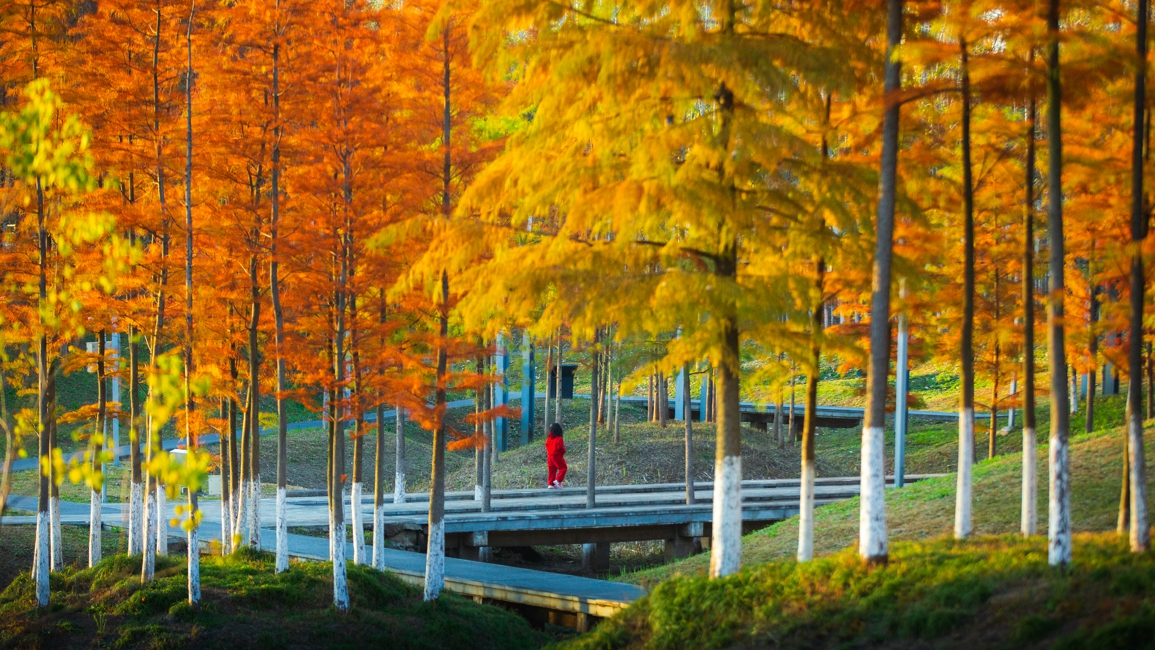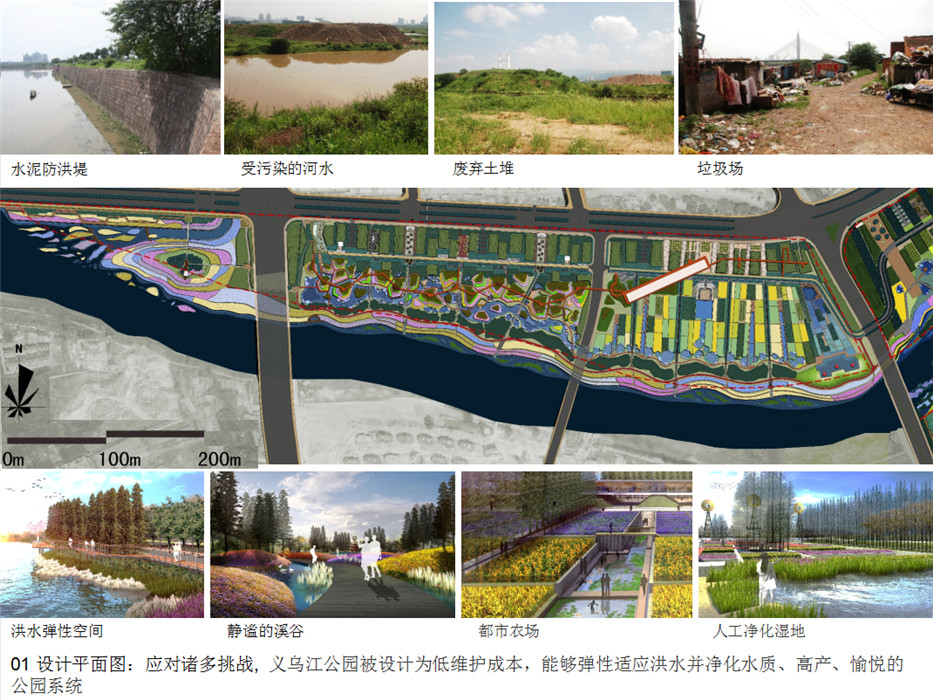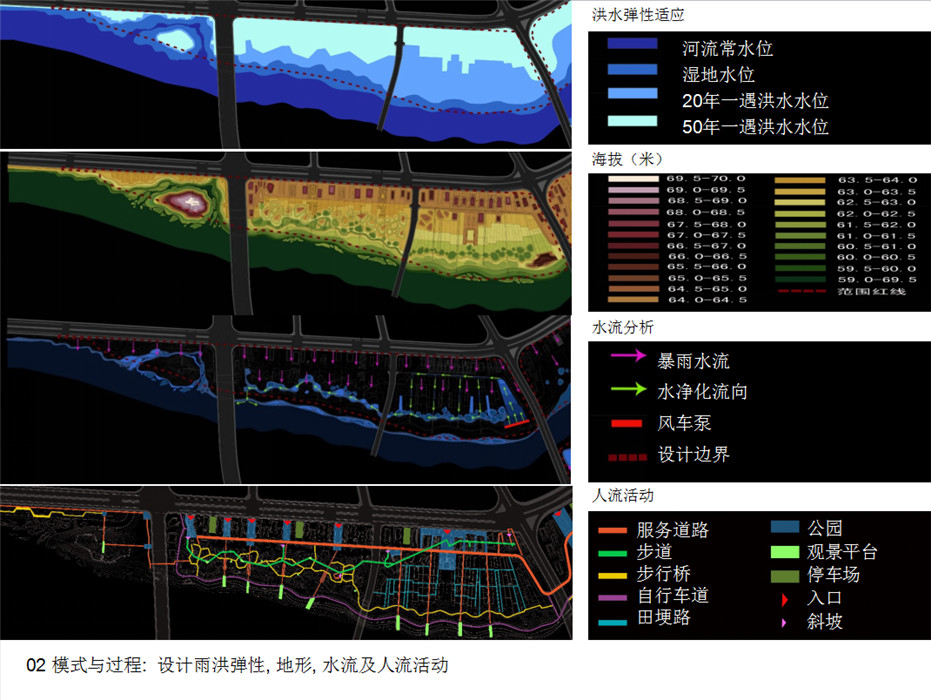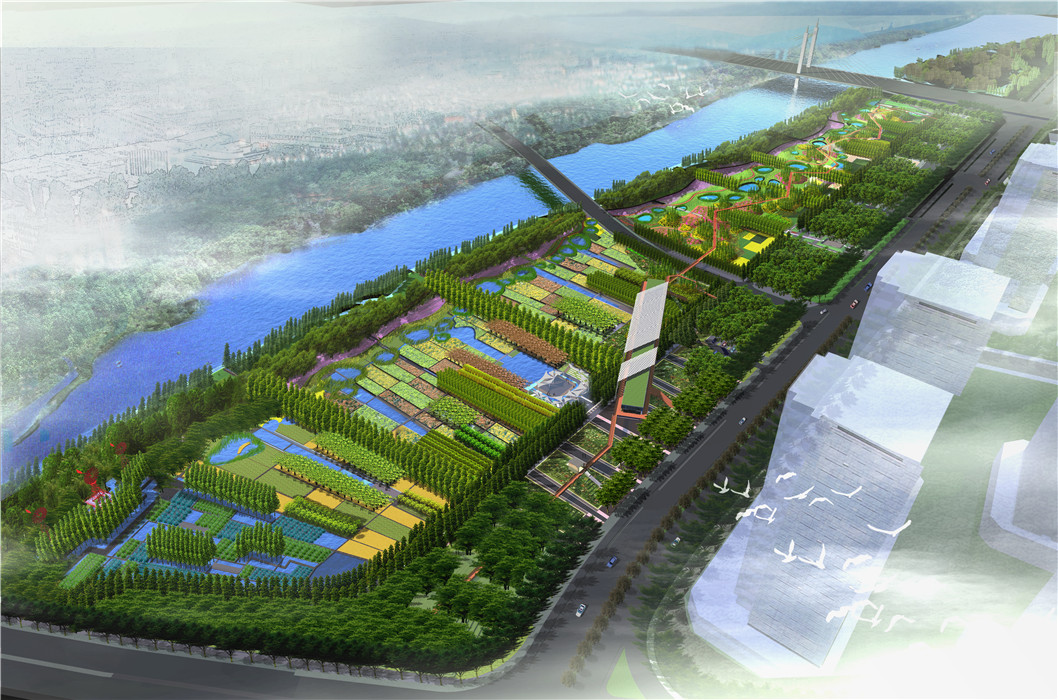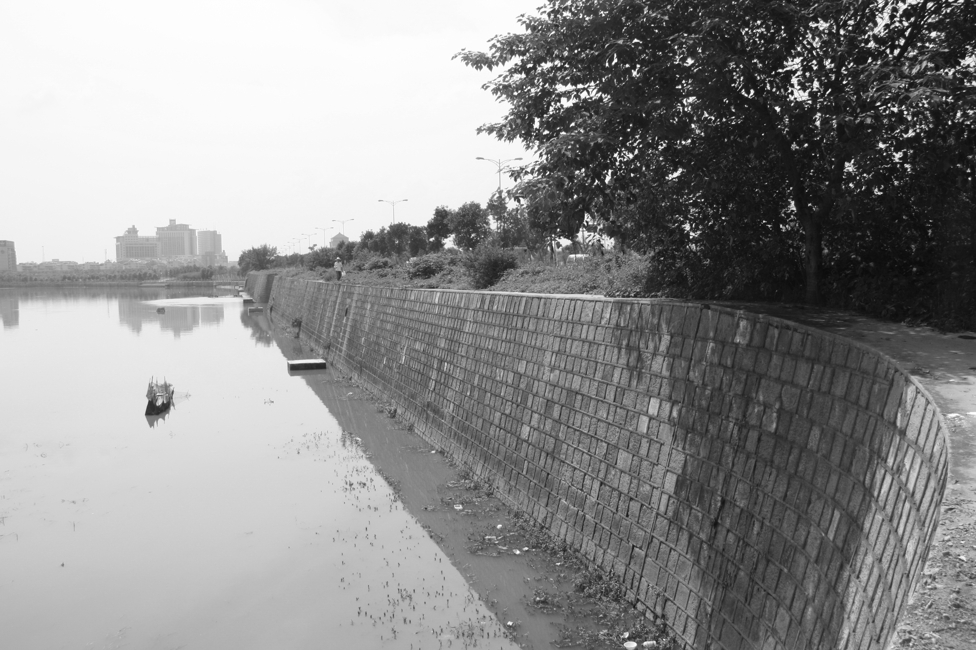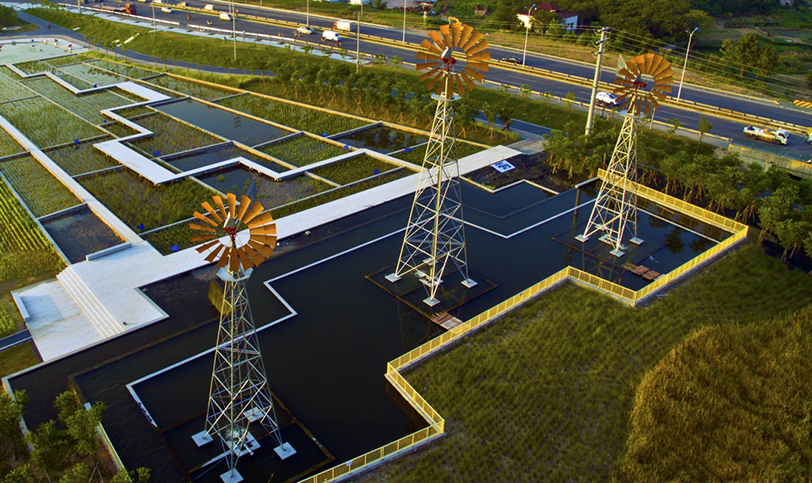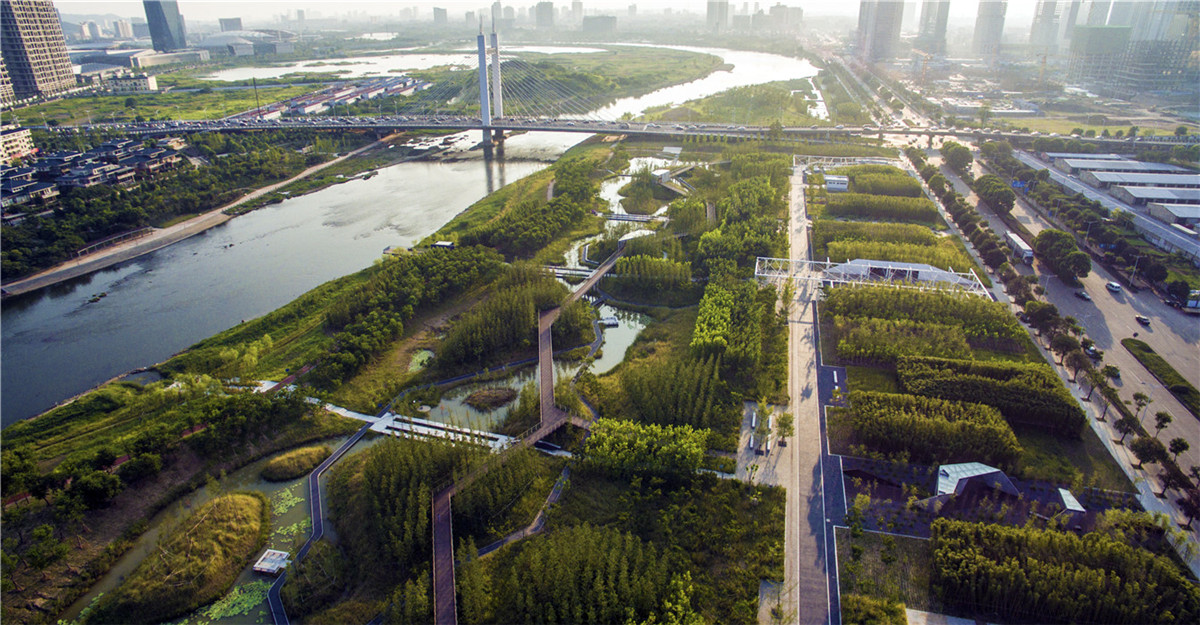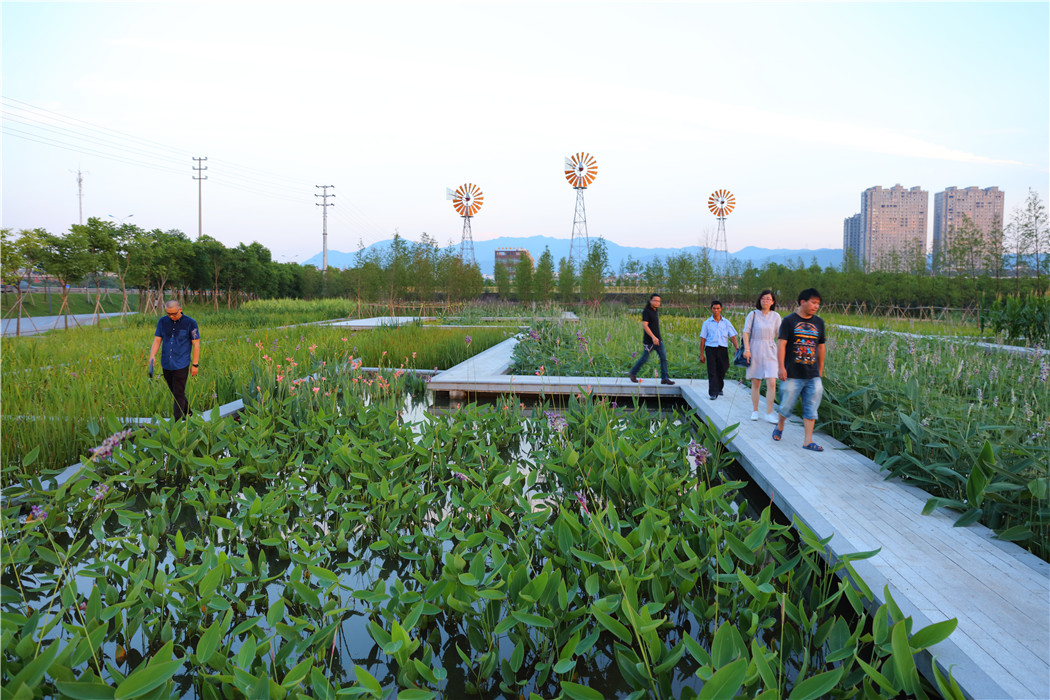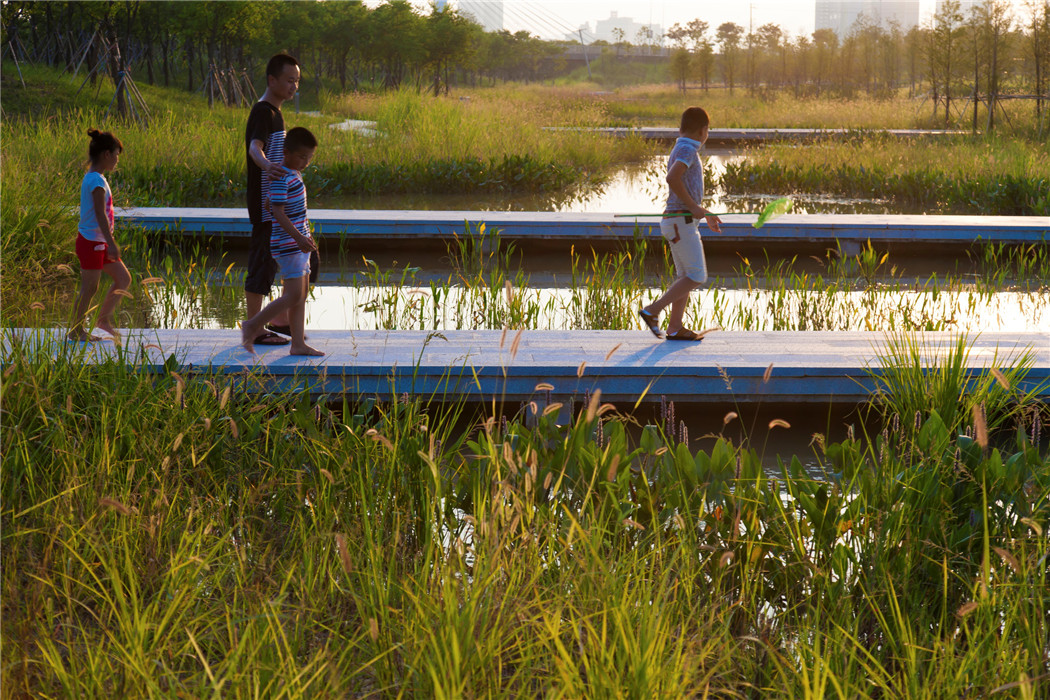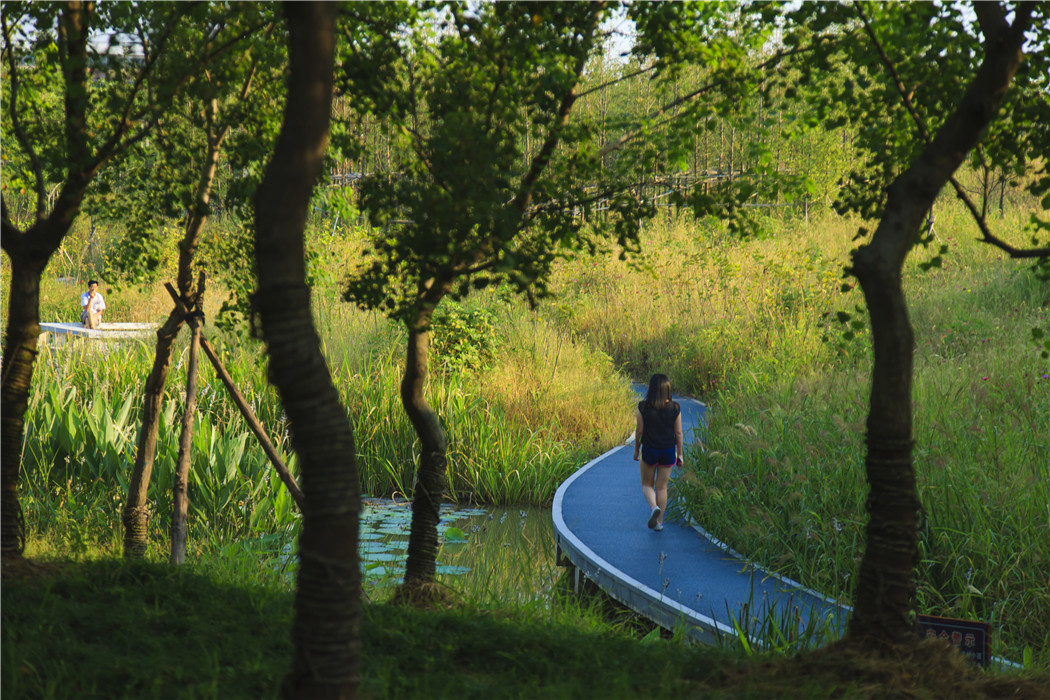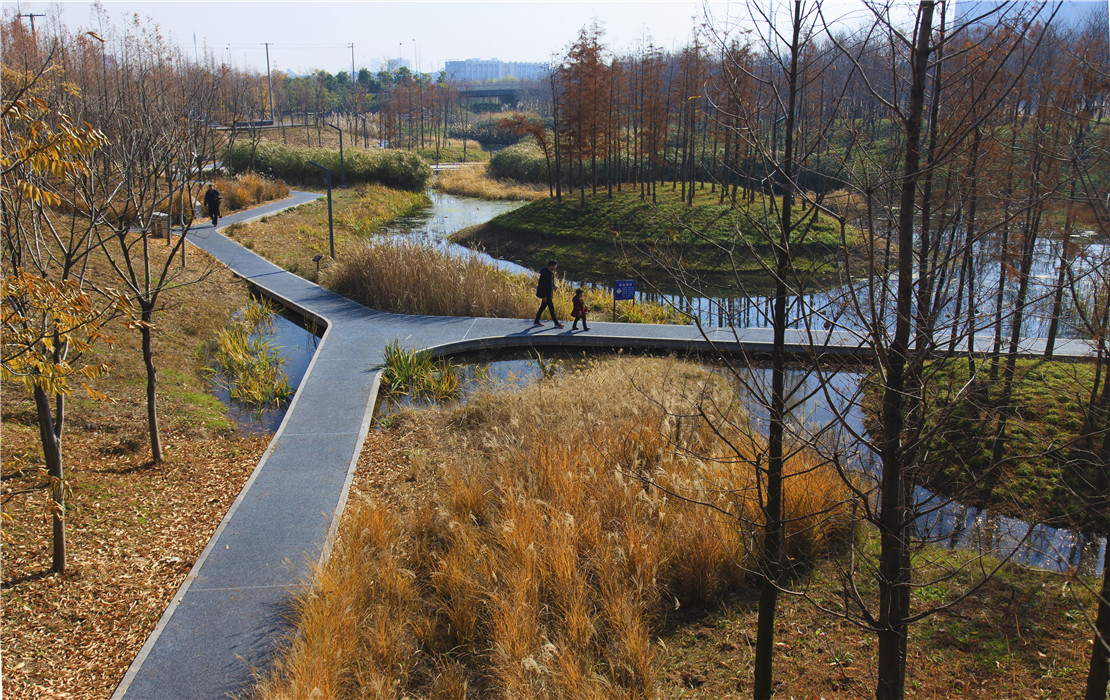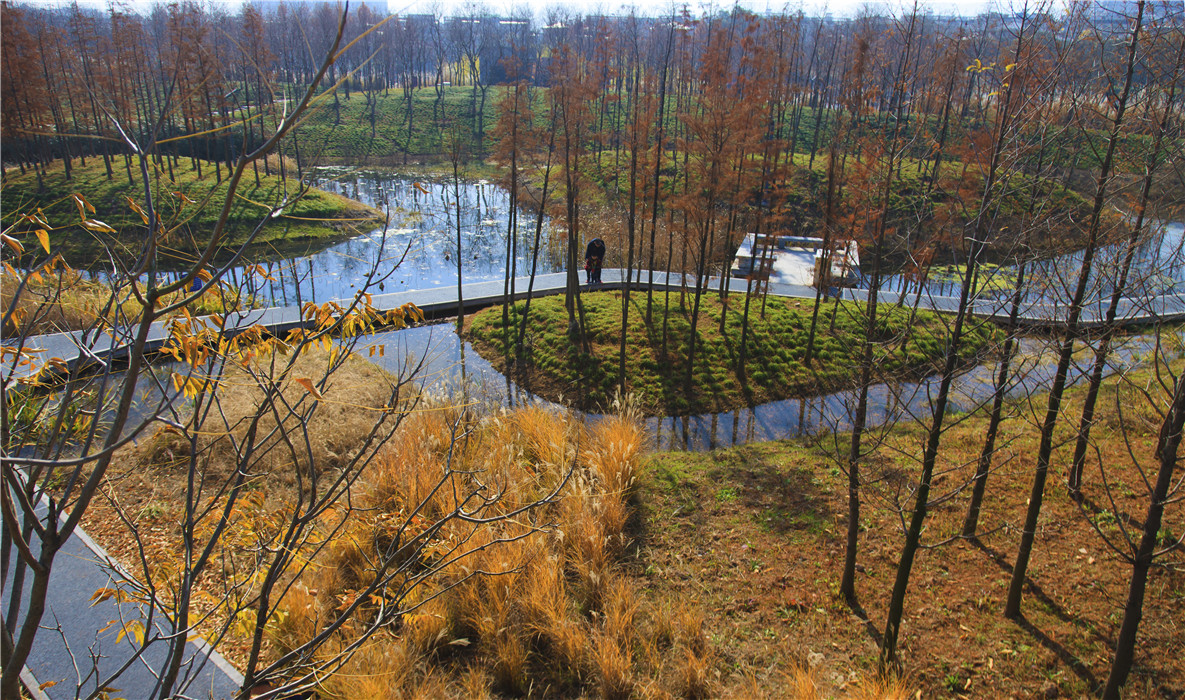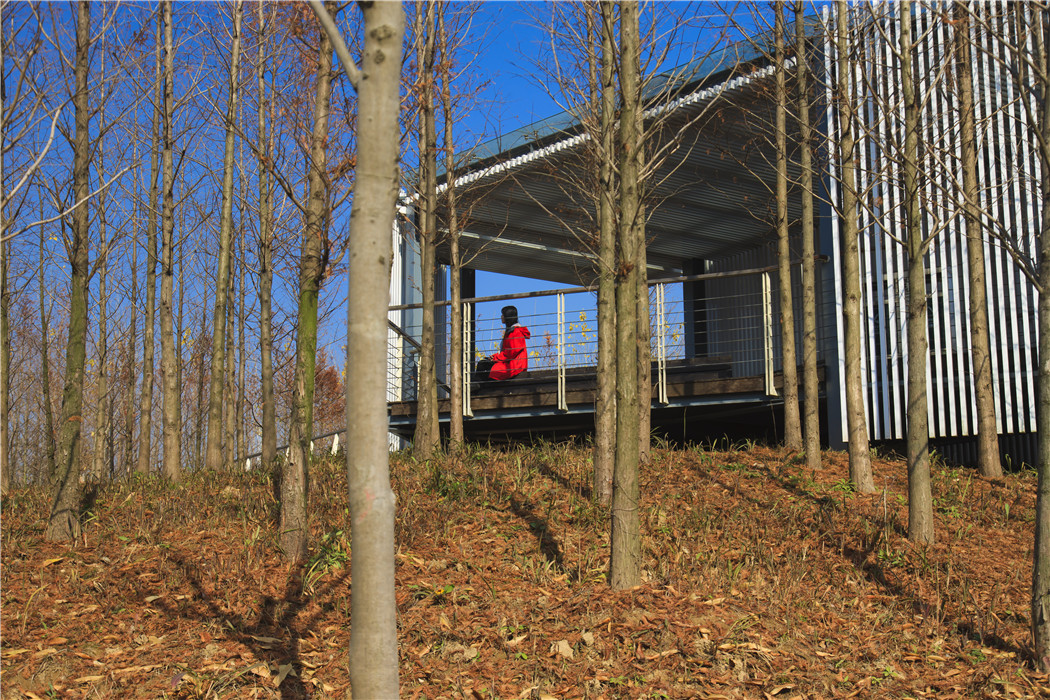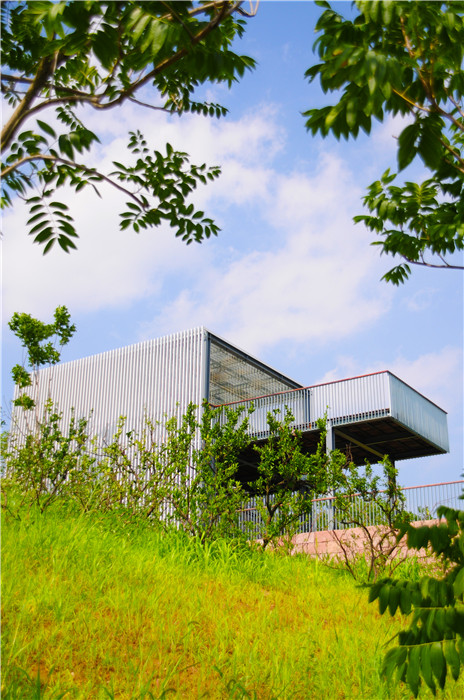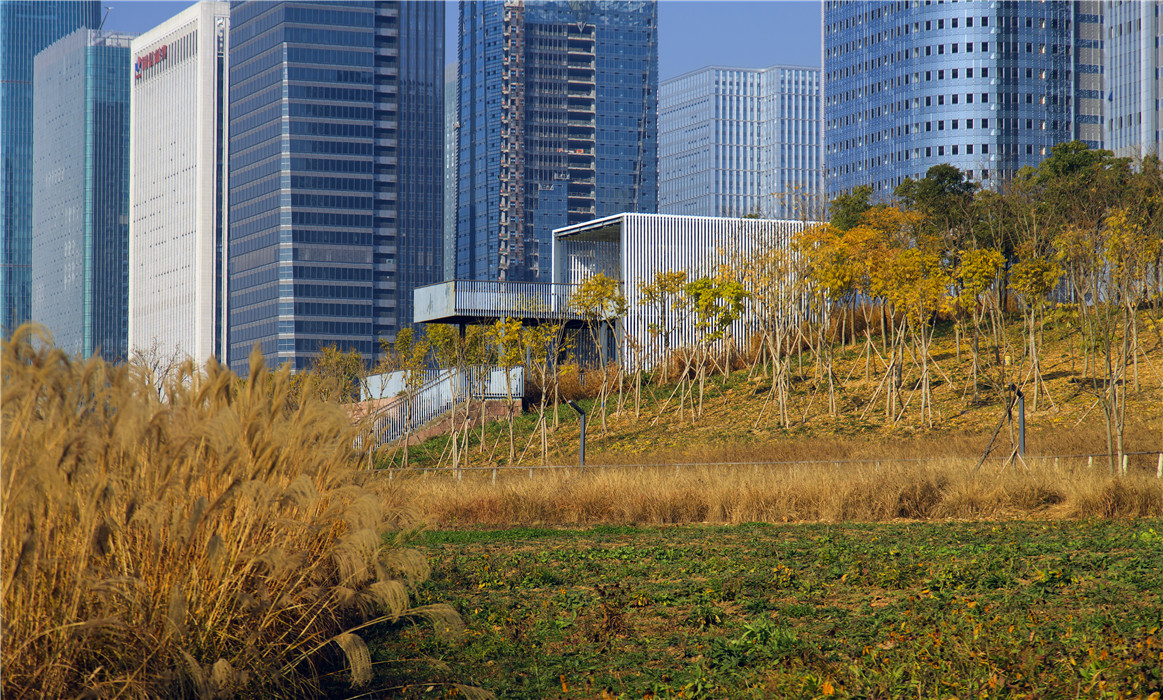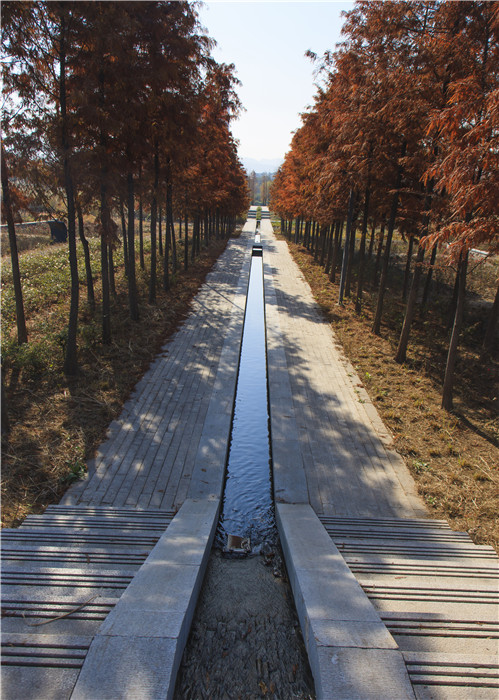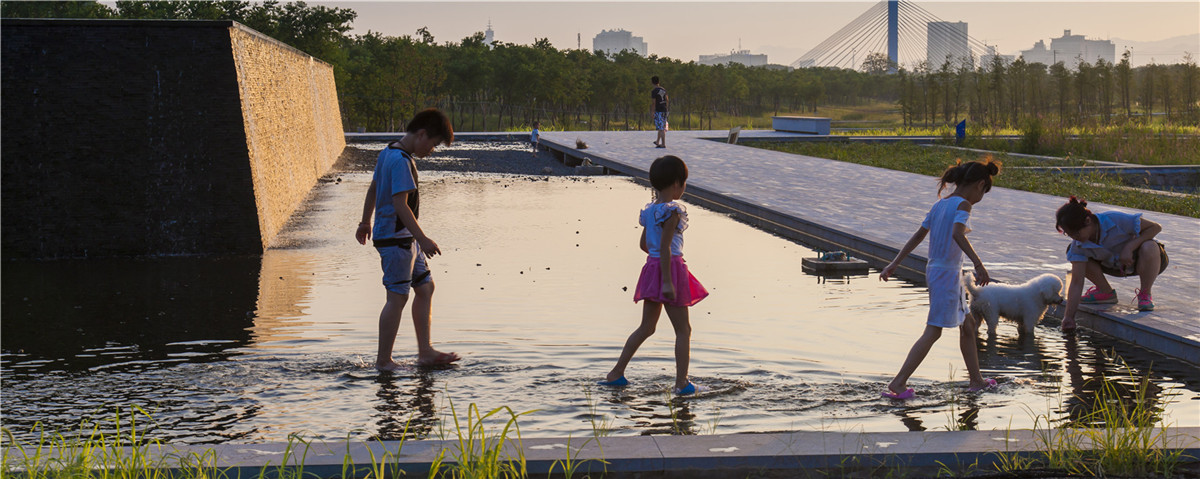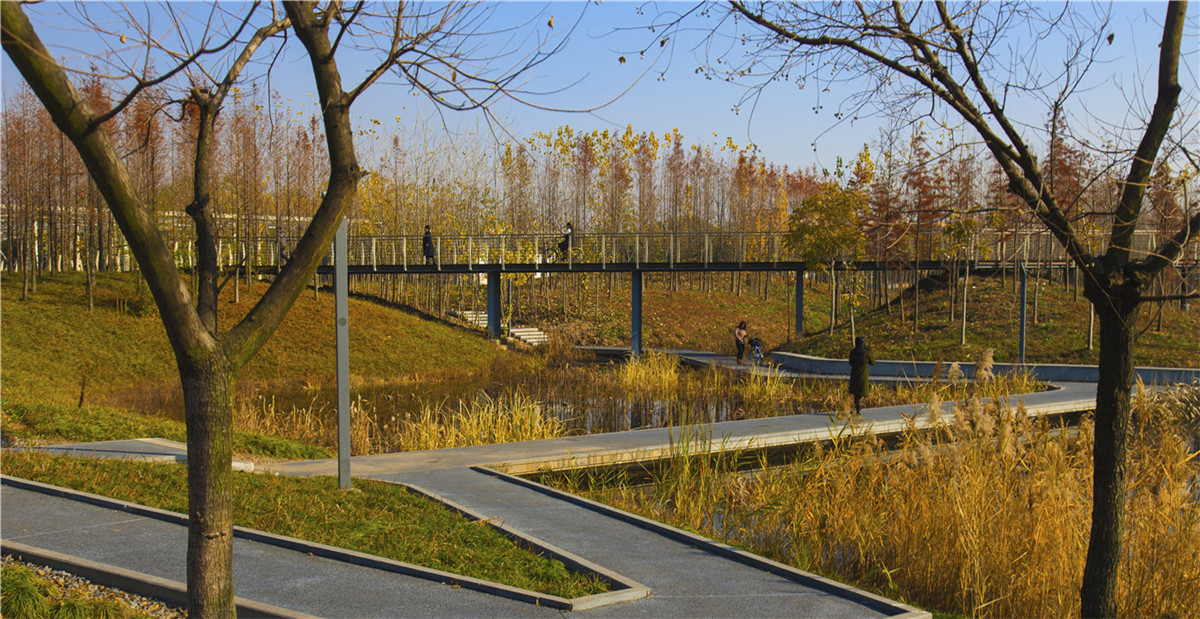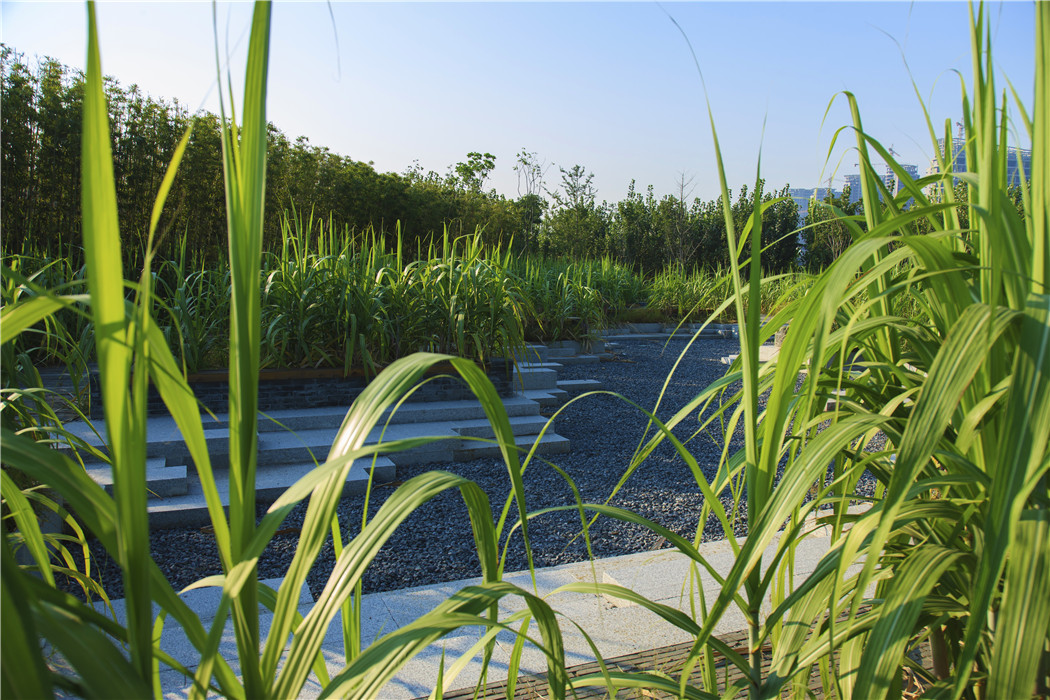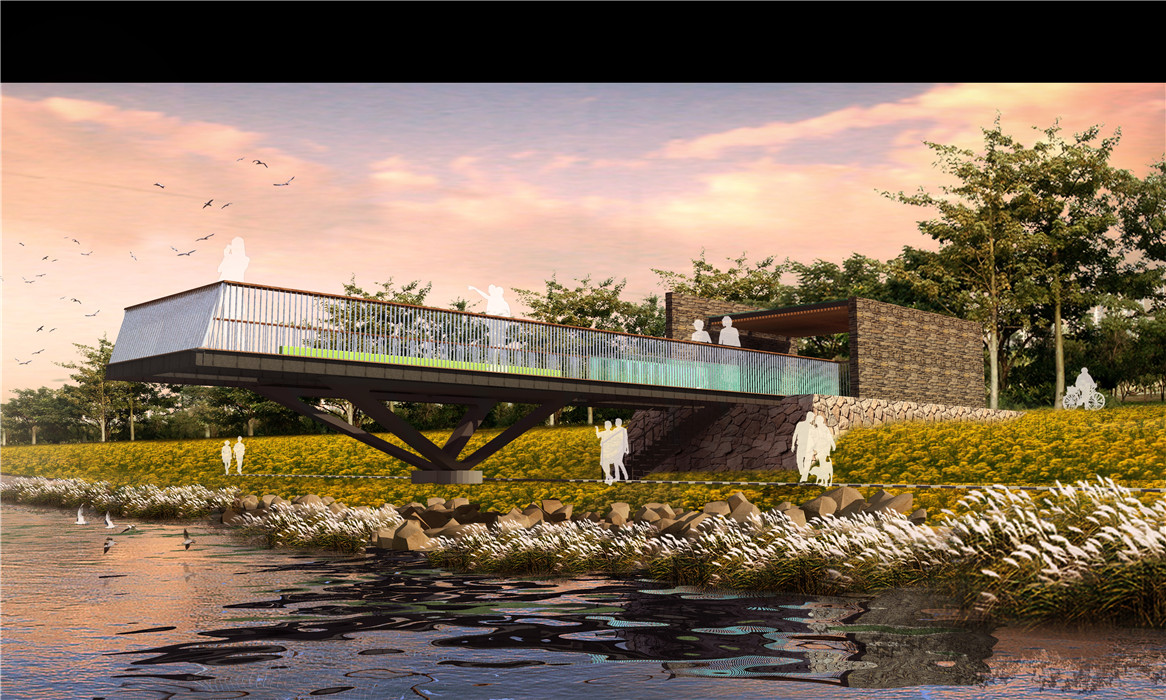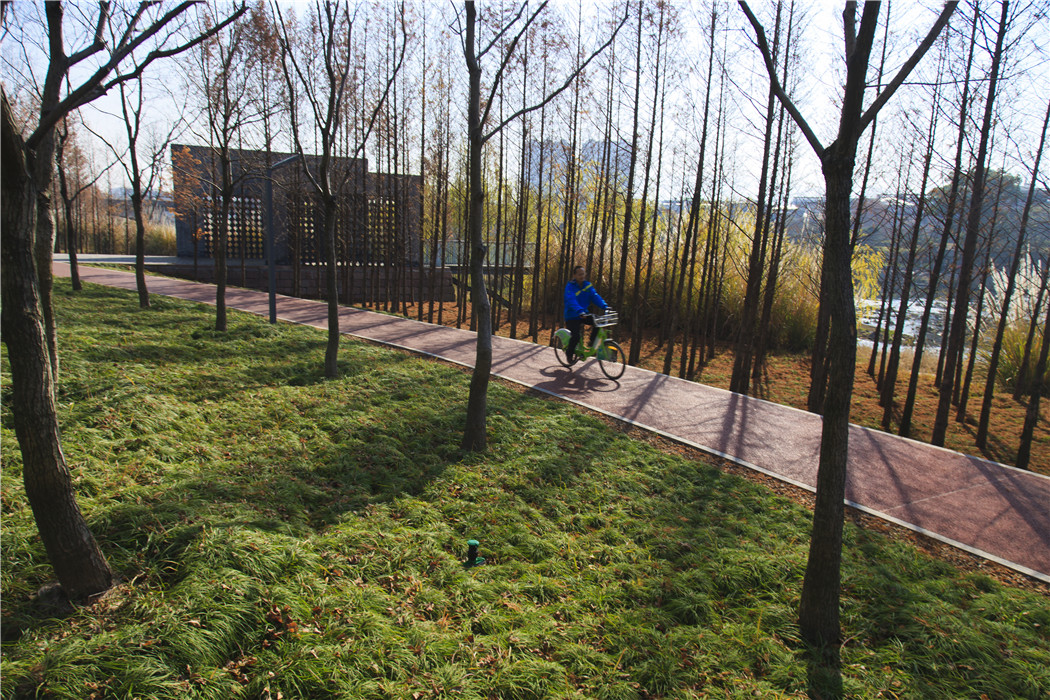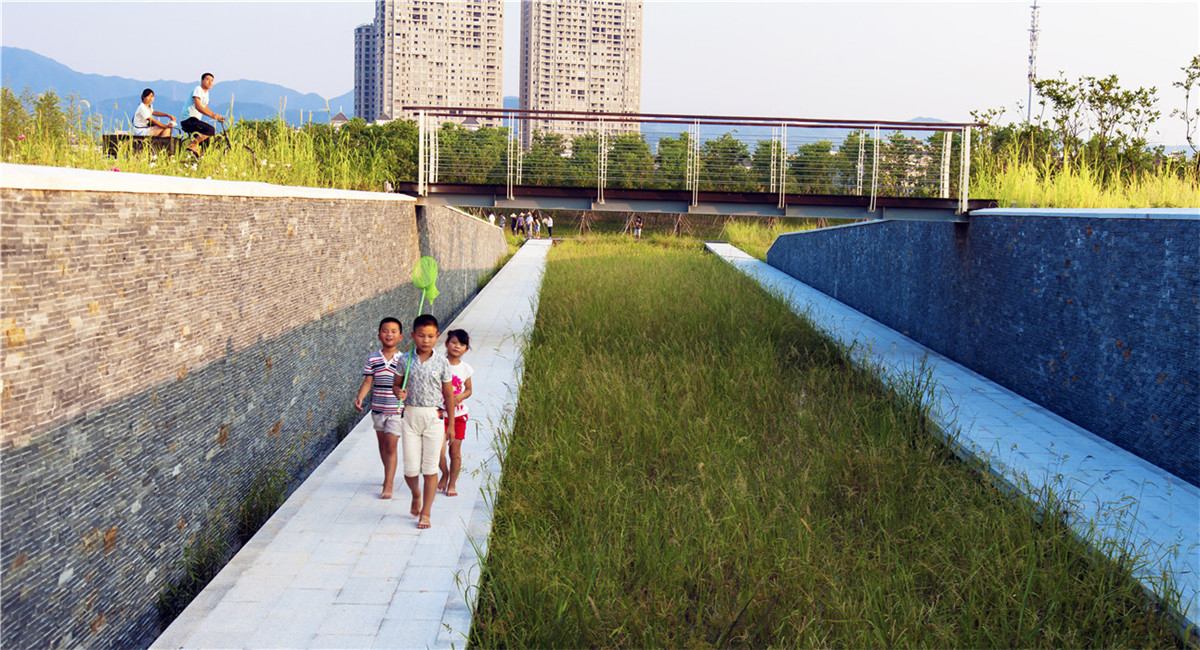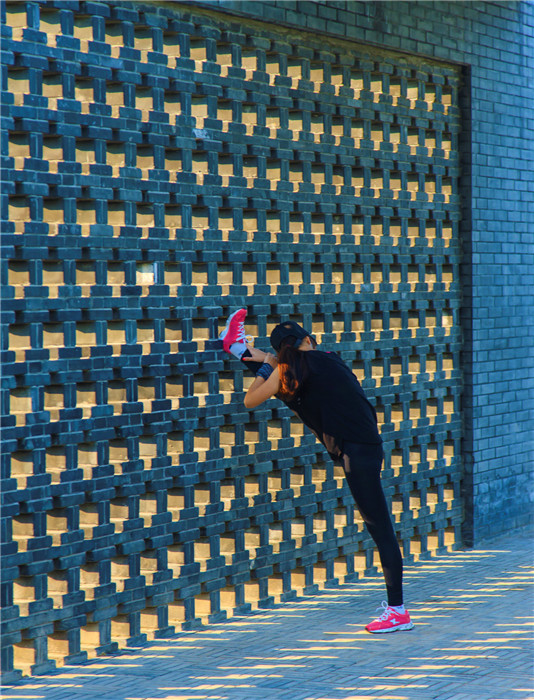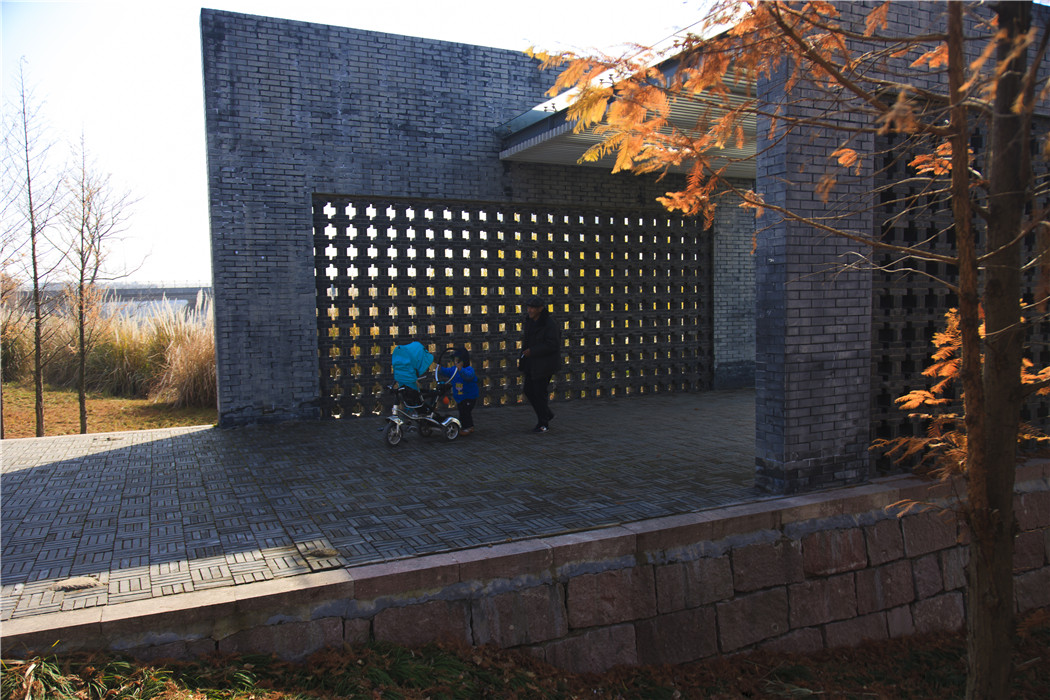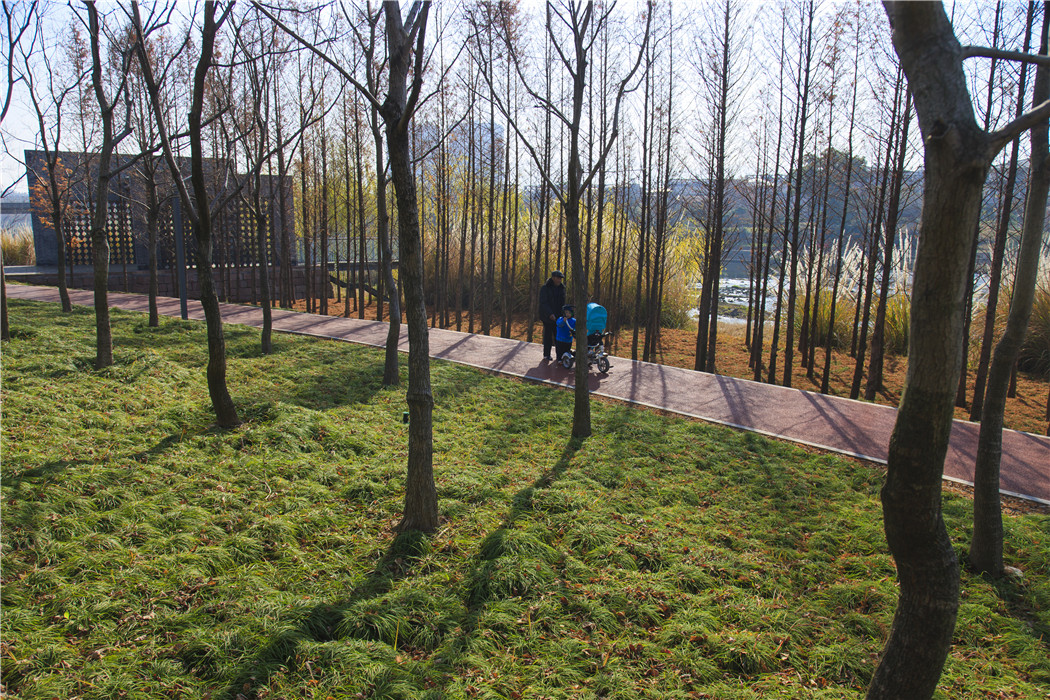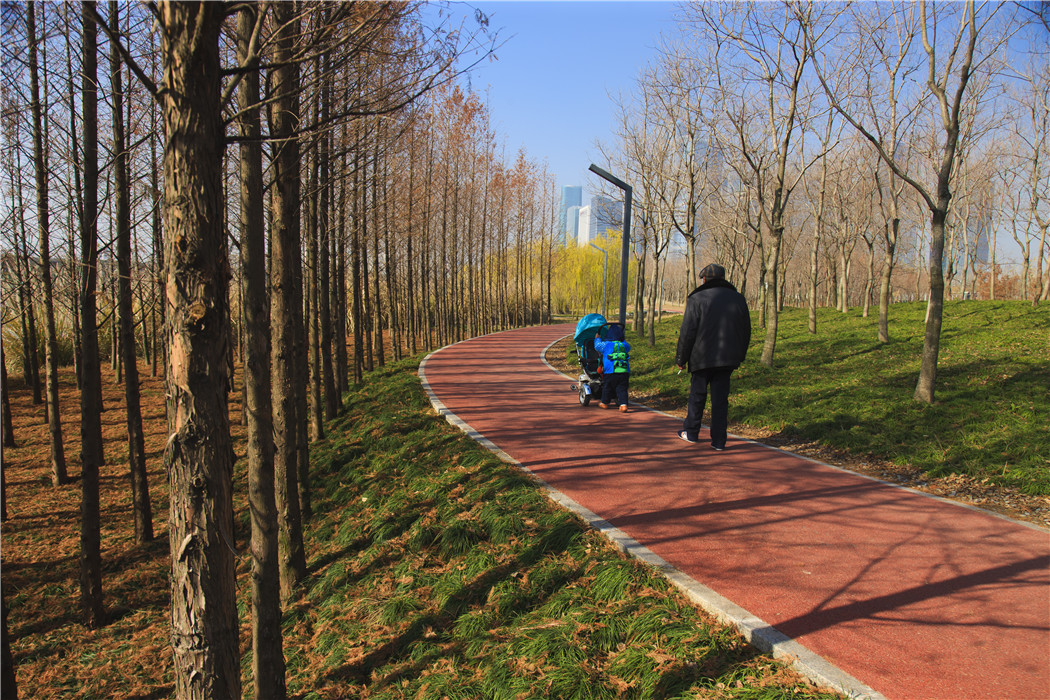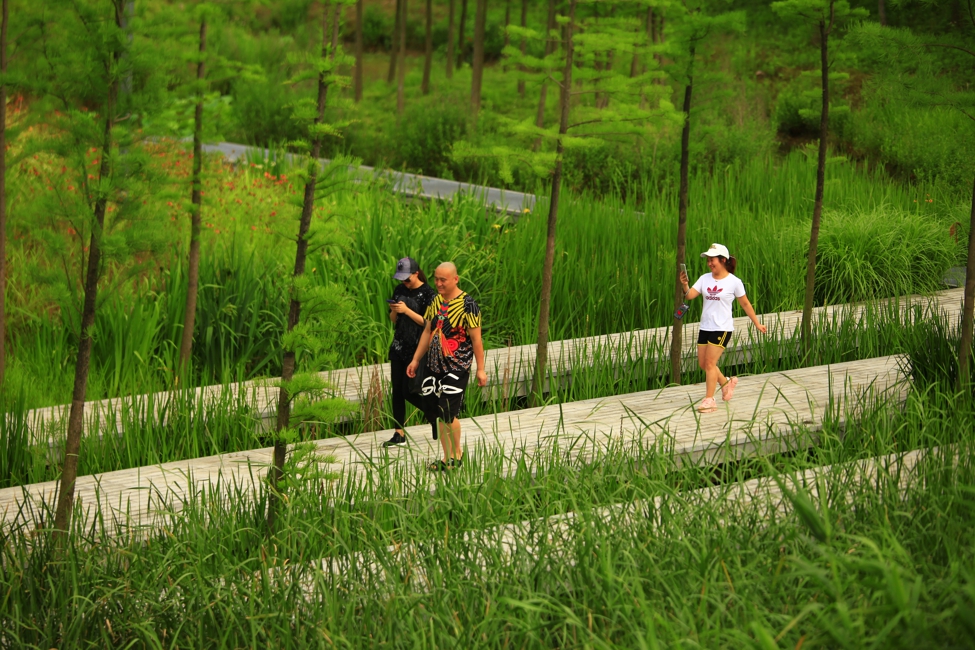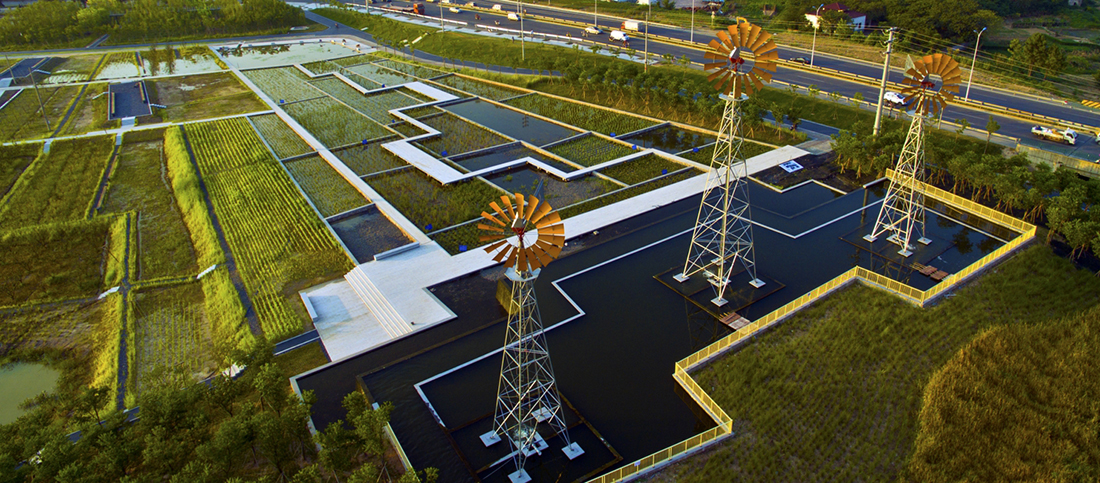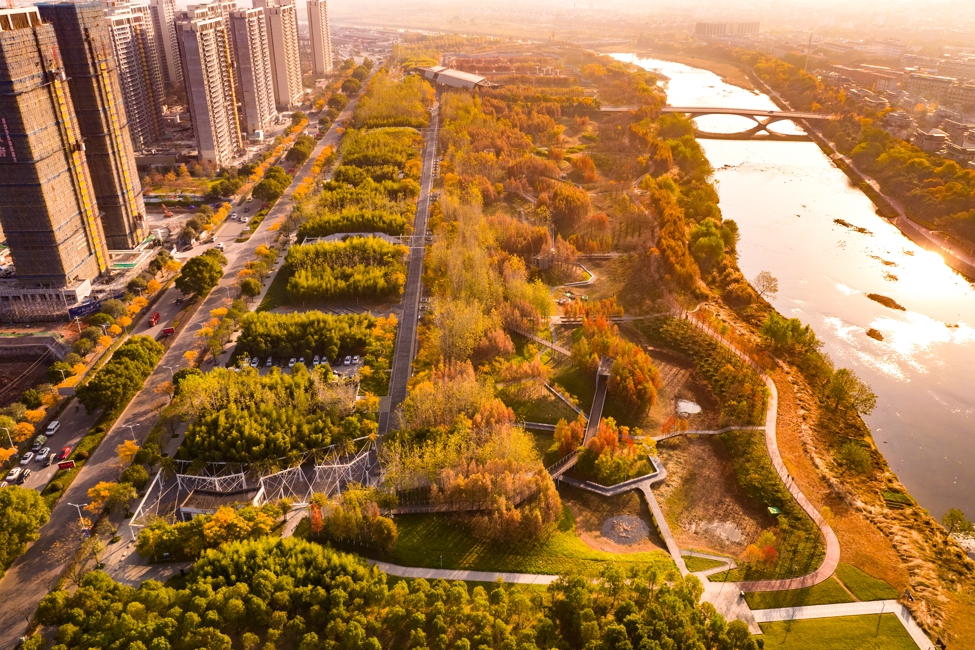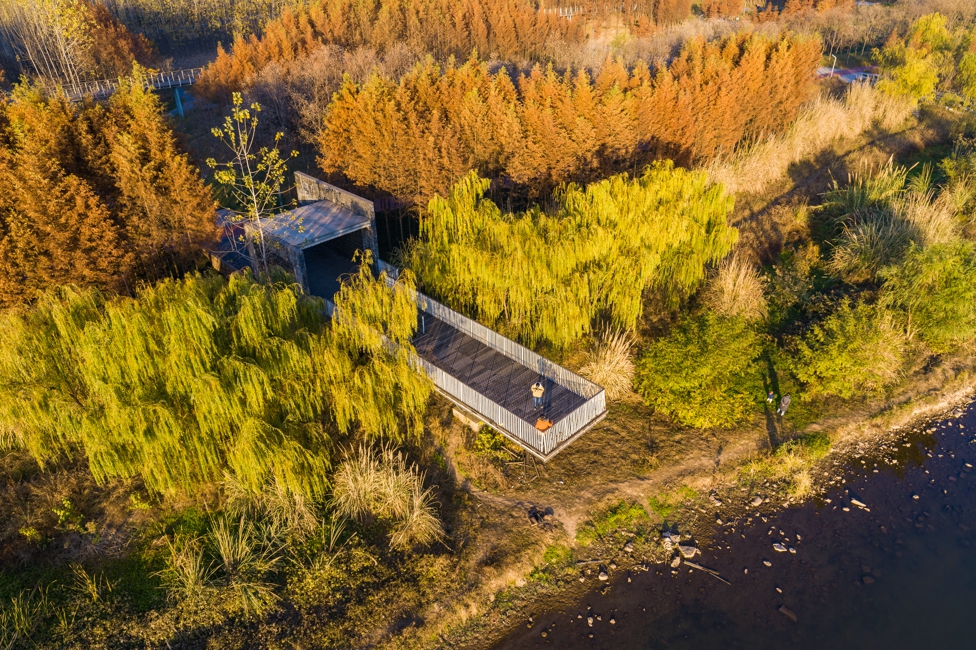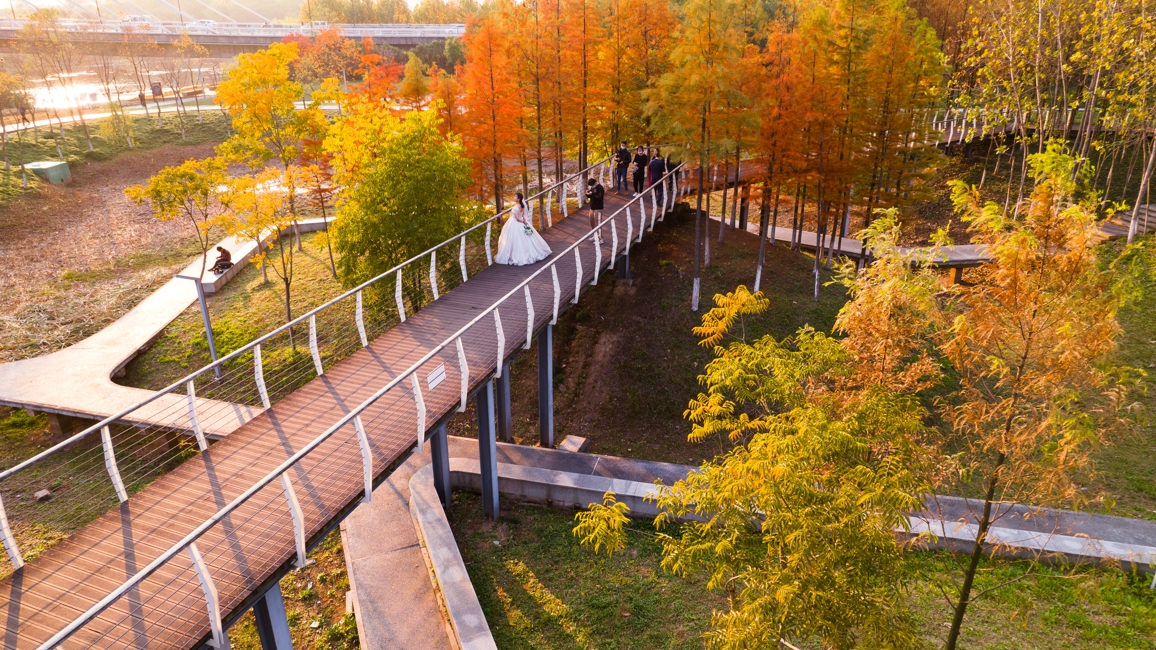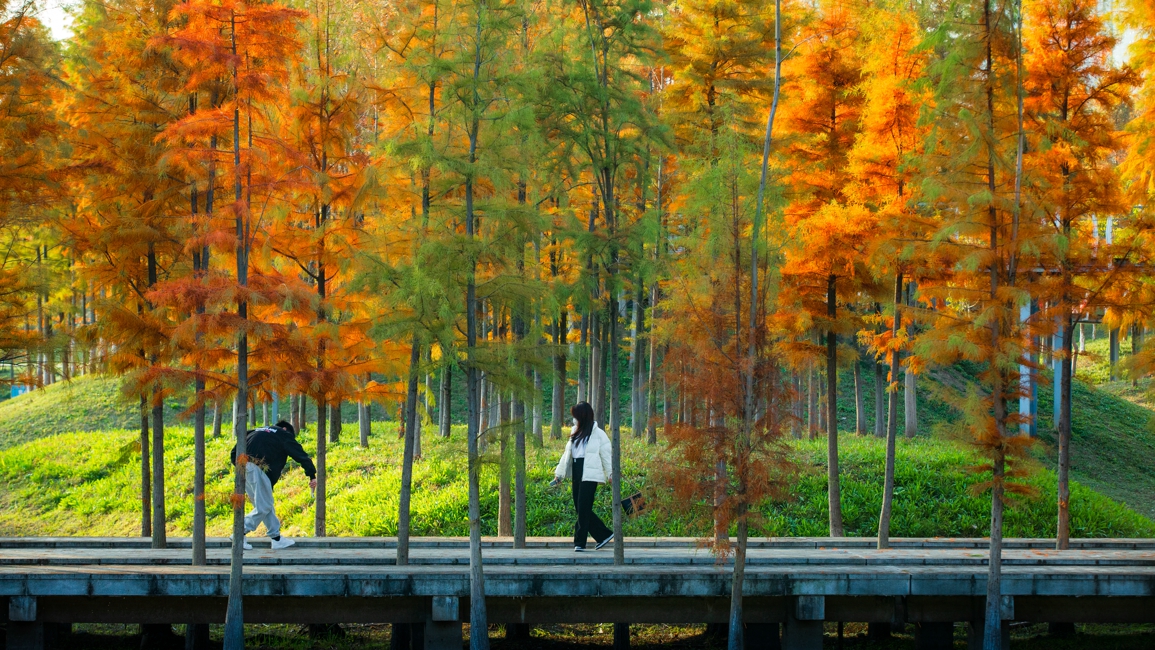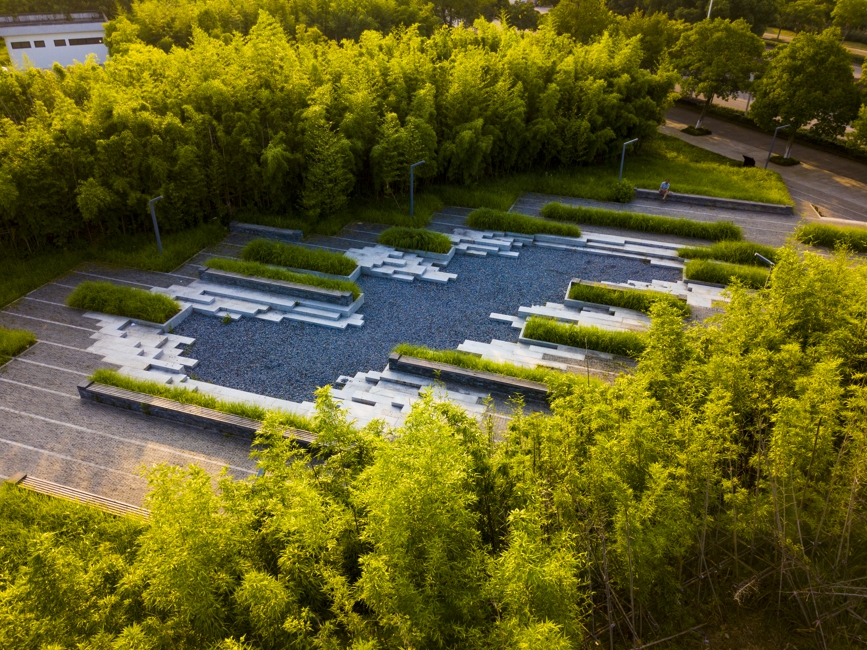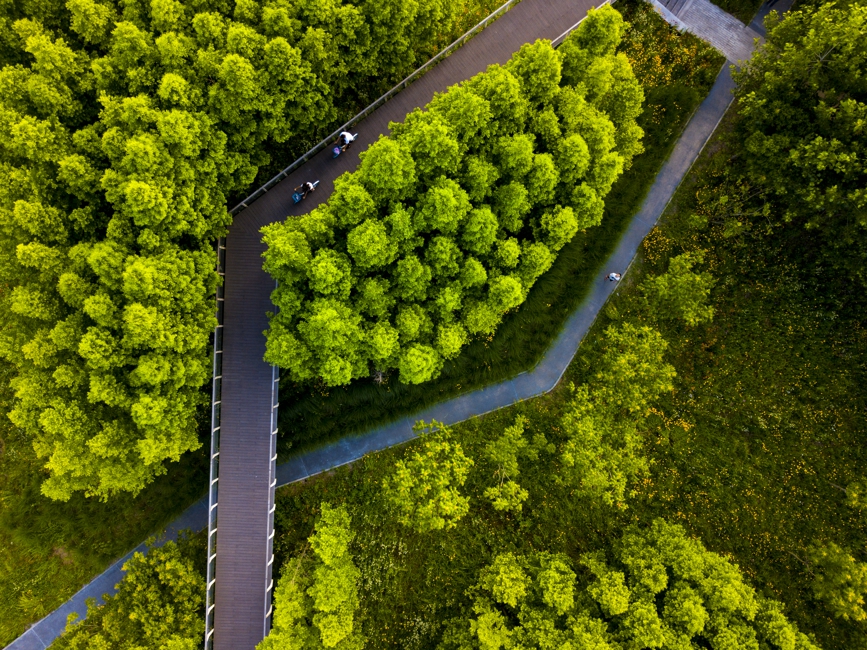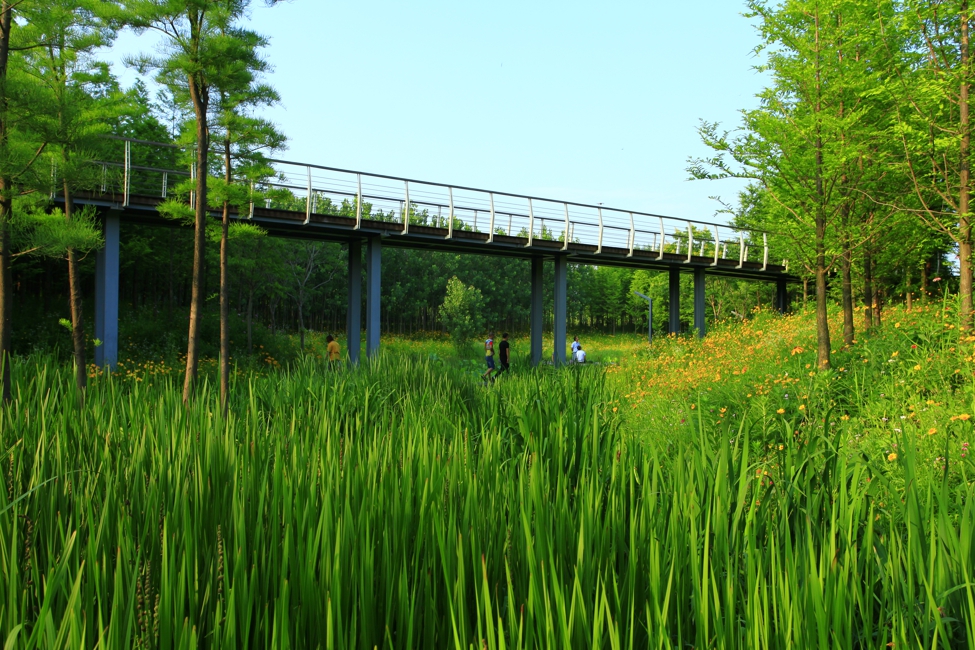Yiwu Riverside Greenway
Project Information
- Project Location:
- China Jinhua, Zhejiang
- Project Scale:
- 28 Hectares
- Design Time:
- June 2009
- Build Time:
- May 2017
- Client:
- Yiwu City Government
Project Profile
1. Project Statement
In order to address a multitude of challenges including flooding hazards, water pollution, abandoned dirt and construction debris, while maintaining both a low budget and low ongoing maintenance costs, and being inspired by local farming wisdom, the Yiwu Riverside Park is designed as a low maintenance working ecosystem that is flood resilient, able to remediate water quality, support native biodiversity, produce food, as well as provide explorative and rich recreational experience.
2. Objective and Challenge
This project is a demonstrative part for a larger urban green corridor along the Yiwu River. It is located right at the future center of the city, and the site presents multiple challenges:
The first challenge is flooding. Influenced by a monsoon climate, the Yiwu River floods during the rainy season. The conventional hydrological engineering solution is to channelize and line the river with concrete.As a matter of fact, part of the river within the site has already been lined with a steep concrete flood wall. This is not acceptable to the landscape architect but what is the alternative?
The second challenge is water pollution. The river water is heavily polluted (eutrophic), worse than V grade, the poorest according to the Chinese classification. This is a problem ubiquitous in China and particularly in this region, where industrial development is most active.
The third challenge is the abandoned dirt on site: A large portion of the site has been taken up by piles of abandoned building debris and dirt from the construction of skyscrapers across the street.
The fourth challenge is the requirement for low maintenance: Due to the large scale of greenery along the Yiwu River, sustainable and low maintenance solutions are important considerations for the government.
In addressing the above multiple challenges, the design objective of the park is to create an ecological infrastructure for the city and demonstrate ecological solutions to remediate flood and cleanse polluted river water, rehabilitate native habitats as well as provide recreational uses for the growing urban population.
3. Design Strategy
To achieve the above objectives and in addressing the multiple challenges of the site, the landscape architect takes the following design strategies.
Resilient levee to make friends with the flood: The former concrete flood wall has been removed, and an eco-friendly earth levee is built to adapt the seasonal flooding. By making the landscaped levee with a cut-and-fill technique, a meandering creek valley (wetland) is created in parallel. Native trees including Metasequoia and Chinese Tallow Tree are grown in groves to create a shaded bike lane on the top of the levee. Flood adaptive pavilions and platforms are built overlooking the flood riparian plain providing visitors with pleasant views along the river corridor.
Inner valley to create a tranquil setting: The cutting of dirt used to build the earth levee creates a valley simultaneously. In addition, the pre-existing piles of dirt are transformed into mounds planted with Metasequoia groves. A network of boardwalks zigzag over the wetland in and among the forested mounds. Immersed in the lush wetland vegetation and “messy” meadow, joggers experience a unique wilderness in an urban setting. A skywalk soaring above the valley that connects the scattered mounds allow the visitors to walk above the canopies while enjoying the ever growing city skyline. Pavilions are built at intervals on the mounds to create focal points and resting places. Such a double layered pedestrian system dramatically increases the carrying capacity of the park and enriches the landscape experience.
A constructed wetland to cleanse the polluted water: East of the park, the eutrophic river water is pumped by three windmills to be cleansed and used for the various purposes. From the sources at the pumps, water is diverted into two courses. In the first course, water is cleansed through a constructed wetland farm inspired by the local rice paddy. Diverse wetland plants are grown in paddies scattered with Pond Cypress. A matrix of boardwalks is built above the paddies. After a systematic cleansing process through the paddies, cleansed water runs into a play pool for people to enjoy in the summer, which then runs into an irrigation system laid out according to the terrain to irrigate the vegetation when needed, and finally runs into the creek valley to nurture the wetland. Another course runs into the creek valley and creates a linear wetland. A series of bio-dykes are built along the creek to slow down the water flow, so that the eutrophic water will nurture the wetland plants and be cleansed at the same time.
Productive crops to recall the rural past: Inspired by the pre-existing farming activities on the site, one third of the park is given to a designed urban farm. Diverse crops are grown, including corn, beans, sorghum, sunflowers, sugarcane, and patches of fruit trees. Inspired by the landscape elements such as ponds and terraces in local farms, designed water features and platforms are allocated in the urban farms to create resting places and unique landscape experiences.
Pocket gardens to make a permeable green boundary: Making use of the piled dirt on site, a raised green boundary covered with dense trees and bamboo separates the park from the street to form a quiet urban oasis within. Meanwhile, pocketed gardens are created at intervals to make the boundary permeable and active. A variety of themes are imbedded into the individual gardens including a sugar cane garden, folk artifacts gardens, and entrance gardens. These themed gardens not only make the otherwise solid greenbelt penetrable, it also activates the peripheral space. Lifted about the ground is a long and porous building to accommodate various services.
4. Conclusion
The built landscape is a favorite for the urban residents for their daily uses. People jog on the boardwalks and on the skywalk in the morning; kids and their happy parents play in the pool in the summer evening, with the water being cleansed through the constructed wetland; even in the steaming mid-day in the hot summer, couples are seen taking rest in the shade of the pavilion that perches on the tops of the mounds. While the elderly enjoy the shade on the paved plaza and platform, the young are seen exploring along the network of paths among the ordered “messy” vegetation in the creek valley. The designed ecologies of this park has turned the abandoned urban land into an high performance and low maintenance ecological infrastructure that provides multiple ecosystems services including flood resilience, water remediation, rehabilitation of native biodiversity, as well as production of food and provision of recreational uses and aesthetic experiences. It has been officially recognized as a demonstrative model by the provincial government for other cities in this region to follow.
